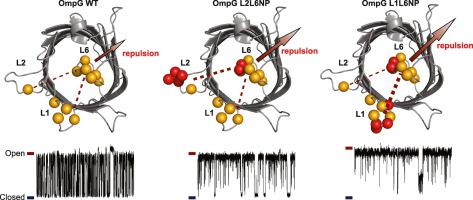Biochimica et Biophysica Acta (BBA) - Biomembranes ( IF 2.8 ) Pub Date : 2020-10-13 , DOI: 10.1016/j.bbamem.2020.183485 Bach Pham 1 , Christina M Chisholm 2 , Joshua Foster 2 , Emily Friis 1 , Monifa A Fahie 2 , Min Chen 3

|
Membrane protein pores have emerged as powerful nanopore sensors for single-molecule detection. OmpG, a monomeric nanopore, is comprised of fourteen β-strands connected by seven flexible extracellular loops. The OmpG nanopore exhibits pH-dependent gating as revealed by planar lipid bilayer studies. Current evidence strongly suggests that the dynamic movement of loop 6 is responsible for the gating mechanism. In this work, we have shown that enhancing the electrostatic repulsion forces between extracellular loops suppressed the pH-dependent gating. Our mutant containing additional negative charges in loop 6 and loop 1 exhibited minimal spontaneous gating and reduced sensitivity to pH changes compared to the wild type OmpG. These results provide new evidence to support the mechanism of OmpG gating controlled by the complex electrostatic network around the gating loop 6. The pH-independent quiet OmpG pores could potentially be used as a sensing platform that operates at a broad range of pH conditions.
中文翻译:

独立于 pH 值的安静 OmpG 孔,在细胞外环之间具有增强的静电排斥
膜蛋白孔已成为用于单分子检测的强大纳米孔传感器。OmpG 是一种单体纳米孔,由 14 条 β 链组成,由 7 个灵活的细胞外环连接。正如平面脂质双层研究所揭示的那样,OmpG 纳米孔表现出依赖于 pH 值的门控。目前的证据强烈表明,回路 6 的动态运动是门控机制的原因。在这项工作中,我们已经表明,增强细胞外环之间的静电排斥力会抑制 pH 依赖性门控。与野生型 OmpG 相比,我们在环 6 和环 1 中含有额外负电荷的突变体表现出最小的自发门控和对 pH 变化的敏感性降低。











































 京公网安备 11010802027423号
京公网安备 11010802027423号